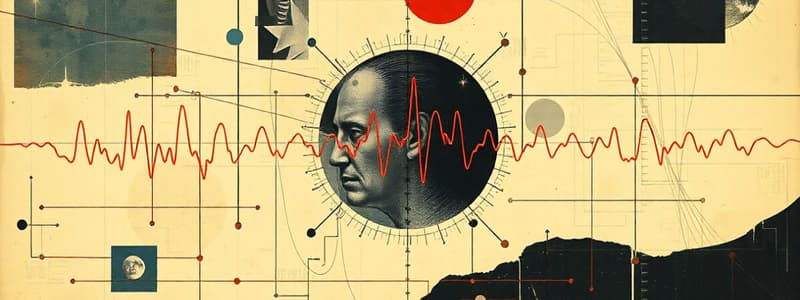Podcast
Questions and Answers
How does frequency affect inductive reactance ($X_L$) and capacitive reactance ($X_C$)?
How does frequency affect inductive reactance ($X_L$) and capacitive reactance ($X_C$)?
- $X_L$ remains constant and $X_C$ decreases with increasing frequency.
- $X_L$ decreases and $X_C$ increases with increasing frequency.
- $X_L$ increases and $X_C$ decreases with increasing frequency. (correct)
- $X_L$ and $X_C$ both increase with increasing frequency.
In a purely capacitive AC circuit, what is the phase relationship between voltage and current?
In a purely capacitive AC circuit, what is the phase relationship between voltage and current?
- Voltage and current are in phase.
- Voltage lags current by 180 degrees.
- Current leads voltage by 90 degrees. (correct)
- Voltage leads current by 90 degrees.
What is the significance of the phase angle ($\theta$) in an AC circuit?
What is the significance of the phase angle ($\theta$) in an AC circuit?
- It represents the magnitude of the impedance.
- It indicates the ratio of resistance to reactance.
- It is only relevant in purely resistive circuits.
- It describes the time difference between voltage and current waveforms. (correct)
What does admittance (Y) measure in an AC circuit, and how is it related to impedance (Z)?
What does admittance (Y) measure in an AC circuit, and how is it related to impedance (Z)?
If a series RLC circuit has $R = 10\Omega$, $X_L = 20\Omega$, and $X_C = 10\Omega$, what is the magnitude of the impedance |Z|?
If a series RLC circuit has $R = 10\Omega$, $X_L = 20\Omega$, and $X_C = 10\Omega$, what is the magnitude of the impedance |Z|?
What is the phase angle ($\theta$) in a purely inductive AC circuit?
What is the phase angle ($\theta$) in a purely inductive AC circuit?
What is the primary goal of impedance matching?
What is the primary goal of impedance matching?
A series RLC circuit has the following component values: R = 10 $\Omega$, $X_L$ = 20 $\Omega$, and $X_C$ = 10 $\Omega$. What is the phase angle between voltage and current?
A series RLC circuit has the following component values: R = 10 $\Omega$, $X_L$ = 20 $\Omega$, and $X_C$ = 10 $\Omega$. What is the phase angle between voltage and current?
Flashcards
Impedance (Z)
Impedance (Z)
Total opposition to AC current, combining resistance and reactance.
Resistance (R)
Resistance (R)
The real part of impedance, representing energy dissipation.
Reactance (X)
Reactance (X)
The imaginary part of impedance, representing energy storage in inductors and capacitors.
Inductive Reactance (XL)
Inductive Reactance (XL)
Signup and view all the flashcards
Capacitive Reactance (XC)
Capacitive Reactance (XC)
Signup and view all the flashcards
Admittance (Y)
Admittance (Y)
Signup and view all the flashcards
Conductance (G)
Conductance (G)
Signup and view all the flashcards
Susceptance (B)
Susceptance (B)
Signup and view all the flashcards
Phase Angle (θ)
Phase Angle (θ)
Signup and view all the flashcards
Series AC Circuit
Series AC Circuit
Signup and view all the flashcards
Parallel AC Circuit
Parallel AC Circuit
Signup and view all the flashcards
Real Power (P)
Real Power (P)
Signup and view all the flashcards
Reactive Power (Q)
Reactive Power (Q)
Signup and view all the flashcards
Apparent Power (S)
Apparent Power (S)
Signup and view all the flashcards
Power Factor (PF)
Power Factor (PF)
Signup and view all the flashcards
Impedance Matching
Impedance Matching
Signup and view all the flashcards
Maximum Power Transfer
Maximum Power Transfer
Signup and view all the flashcards
Study Notes
- Impedance and admittance are fundamental concepts in AC circuits, extending the idea of resistance to include the effects of capacitance and inductance.
Impedance (Z)
- Impedance (Z) is the total opposition a circuit presents to alternating current (AC).
- It's the AC equivalent of resistance in DC circuits.
- Impedance is a complex quantity, consisting of two parts: resistance (R) and reactance (X).
- The formula is expressed as Z = R + jX, where 'j' is the imaginary unit.
- Resistance (R) is the real part of impedance, representing the opposition to current due to energy dissipation (e.g., in resistors).
- Reactance (X) is the imaginary part of impedance, representing the opposition to current due to energy storage (e.g., in inductors and capacitors).
- Inductive reactance (XL) is the opposition to current flow caused by an inductor, given by XL = 2πfL, where f is the frequency and L is the inductance.
- Inductive reactance increases with frequency.
- Capacitive reactance (XC) is the opposition to current flow caused by a capacitor, given by XC = 1/(2πfC), where f is the frequency and C is the capacitance.
- Capacitive reactance decreases with frequency.
- The unit of impedance is ohms (Ω).
- The magnitude of impedance |Z| = √(R² + X²).
- The phase angle (θ) between voltage and current is given by θ = arctan(X/R).
- In a purely resistive circuit, Z = R, and the phase angle is 0°.
- In a purely inductive circuit, Z = jXL, and the phase angle is 90°. Voltage leads current.
- In a purely capacitive circuit, Z = -jXC, and the phase angle is -90°. Current leads voltage .
- For a series RLC circuit, Z = R + j(XL - XC).
- For a parallel RLC circuit, the total impedance is calculated using admittances.
Admittance (Y)
- Admittance (Y) is the reciprocal of impedance.
- Admittance measures how easily an AC circuit allows current to flow.
- Admittance is also a complex quantity, consisting of two parts: conductance (G) and susceptance (B).
- The formula is expressed as Y = G + jB.
- Conductance (G) is the real part of admittance, representing the ease with which current flows through a resistor.
- Admittance is the reciprocal of resistance (G = 1/R).
- Susceptance (B) is the imaginary part of admittance, representing the ease with which current flows through a capacitor or inductor.
- Inductive susceptance (BL) is the susceptance due to an inductor, given by BL = -1/(2πfL).
- Capacitive susceptance (BC) is the susceptance due to a capacitor, given by BC = 2πfC.
- The unit of admittance is siemens (S).
- The magnitude of admittance |Y| = √(G² + B²).
- The phase angle (θ) between voltage and current is given by θ = arctan(B/G).
- In a purely resistive circuit, Y = G, and the phase angle is 0°.
- In a purely inductive circuit, Y = -jBL, and the phase angle is -90°.
- In a purely capacitive circuit, Y = jBC, and the phase angle is 90°.
- For parallel circuits, calculating total admittance is simpler than calculating total impedance.
- Y = 1/Z; G = R / (R² + X²); B = -X / (R² + X²).
Series AC Circuits
- Components are connected end-to-end, so the same current flows through each component.
- The total impedance is the sum of individual impedances: Ztotal = Z1 + Z2 + Z3 + ...
- The voltage across each component will be different, depending on its impedance.
- The phase angle can be determined from the ratio of total reactance to total resistance.
- Example: In a series RL circuit, Z = R + jXL.
- Example: In a series RC circuit, Z = R - jXC.
- Example: In a series RLC circuit, Z = R + j(XL - XC).
Parallel AC Circuits
- Components are connected side-by-side, so the same voltage is across each component.
- The total admittance is the sum of individual admittances: Ytotal = Y1 + Y2 + Y3 + ...
- The current through each component will be different, depending on its admittance.
- The total impedance can be found by taking the reciprocal of the total admittance: Ztotal = 1/Ytotal.
- Example: In a parallel RL circuit, Y = (1/R) - j(1/XL).
- Example: In a parallel RC circuit, Y = (1/R) + j(1/XC).
- Example: In a parallel RLC circuit, Y = (1/R) + j( (1/XC) - (1/XL) ).
Power in AC Circuits
- Instantaneous power in an AC circuit varies with time.
- Average power, also known as real power (P), is the power actually dissipated in the circuit, usually by the resistor.
- Real power is measured in watts (W).
- Reactive power (Q) is the power exchanged between the source and the reactive components (inductors and capacitors).
- Reactive power is not dissipated but stored and returned to the source.
- Reactive power is measured in volt-amperes reactive (VAR).
- Apparent power (S) is the total power supplied by the source, the vector sum of real and reactive power.
- Apparent power is measured in volt-amperes (VA).
- The power factor (PF) is the ratio of real power to apparent power: PF = P/S = cos(θ), where θ is the phase angle between voltage and current.
- A power factor of 1 indicates a purely resistive circuit (ideal).
- A power factor of 0 indicates a purely reactive circuit (no real power dissipation).
- Power factor correction involves adding capacitance or inductance to the circuit to bring the power factor closer to 1, improving efficiency.
- Real Power (P) = V * I * cos(θ)
- Reactive Power (Q) = V * I * sin(θ)
- Apparent Power (S) = V * I
Impedance Matching
- Impedance matching is the process of designing the input impedance of a load to equal the output impedance of the signal source.
- It maximizes power transfer from the source to the load.
- Impedance matching is particularly important in radio frequency (RF) circuits and audio systems.
- A common method for impedance matching is using a transformer. The turns ratio of the transformer can be selected to match the impedances.
- Another method is using a matching network consisting of inductors and capacitors.
- When the load impedance is not matched to the source impedance, reflections can occur, reducing power transfer and potentially damaging the source.
- Maximum power transfer occurs when Zsource = Zload*, where Zload* is the complex conjugate of the load impedance.
Studying That Suits You
Use AI to generate personalized quizzes and flashcards to suit your learning preferences.




